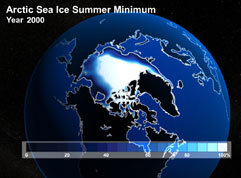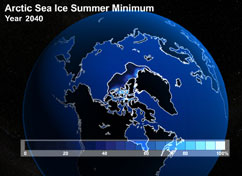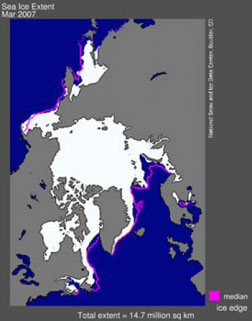2007 Arctic sea ice extent second lowest on record
Arctic sea ice extent second lowest on record
mongabay.com
April 4, 2007
Winter sea ice in the Arctic was the second smallest area on record, narrowly missing the 2006 mark, according to scientists from the University of Colorado’s National Sea and Ice Data Center (NSIDC).
  The image from 2000, based on simulations produced by the Community Climate System Model, shows the approximate extent of Arctic sea ice in September. The model indicates the extent of this late-summer ice could begin to retreat abruptly within several decades (top). By about 2040, the Arctic may be nearly devoid of sea ice during the late summer unless greenhouse gas emissions are significantly curtailed (bottom). Courtesy of UCAR.
|
Sea ice extent, or the area of ocean that is covered by at least 15 percent ice, was 5.7 million square miles (14.7 million sq km) in March, slightly higher than the record low of 5.6 million square miles (14.5 million sq km) measured in March 2006. March usually marks the maximum extent of sea ice in the Arctic.
Walt Meier, an NSIDC researcher, blamed rising concentrations of greenhouse gases in the atmosphere and strong natural variability in the ice for the decline.
“This year’s wintertime low extent is another milestone in a strong downward trend,” said Meier. “We’re still seeing near-record lows (in sea ice) and higher-than-normal temperatures, and we expect this downward trend to continue in future years.”
A study published last month by NSIDC scientist Mark Serreze in the journal Science showed that “sea-ice extent trends have been negative for every month since 1979, when reliable satellite record-keeping efforts began.” Since that year sea ice extent has fallen by about 7 percent or about 38,000 square miles (98,000 sq km) of ice annually.
Scientists are concerned that the Arctic may be approaching a point where sea ice melt could rapidly accelerate.
“Melting ice means more of the dark ocean is exposed, allowing it to absorb more of the sun’s energy, further increasing air temperatures, ocean temperatures, and ice melt,” said CU-Boulder scientist Ted Scambos in a statement last October. “It seems that this feedback, which is a major reason for the pronounced effects of greenhouse warming in the arctic, is really starting to kick in.”
“I’m not terribly optimistic about the future of the ice,” Serreze added. “As greenhouse gases continue to rise, the Arctic will continue to lose its ice. You just can’t argue with the physics.”
Research published in the December 12 issue of Geophysical Research Letters. warned that the Arctic Ocean could have ice-free summers by 2040, putting polar bears and other species at risk.
This article is based on a news release from NSIDC and previous mongabay.com articles
